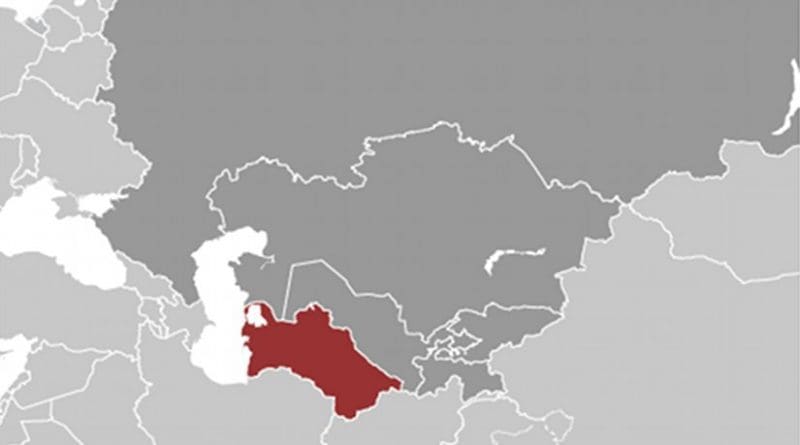Turkmenistan’s New $1.5 Billion Port: Show Over Substance?
By Eurasianet
Accolades are rolling in for cash-strapped, cut-off Turkmenistan’s newly opened $1.5 billion port on the Caspian Sea, although nobody quite seems able to say how it will be put to use.
The Turkmenbashi Sea Port – opened on May 2 – is yet another major outlay that the country’s government committed to in the boom years of high gas prices.
Projects on an even larger scale included infrastructure for an obscure sporting event held last year, which cost upwards of $5 billion, and a falcon-shaped airport in the capital, Ashgabat, that cost around $2.5 billion.
The stadia and other embellishments for the Asian Indoor and Martial Arts Games were pure vanity spending, completed against the backdrop of a deepening hard currency crisis.
The government has touted the new airport in Ashgabat and the modernized Turkmenbashi seaport as investments in trade and transit that will provide strong returns. Label-fond authorities have even gone as far as branding 2018 with the logo “Turkmenistan: Heart of the Great Silk Road,” while trade and transit got top billing in a New Year address given by President Gurbanguly Berdymukhamedov.
Berdymukhamedov stressed this theme again at the unveiling of the port, which was built by Turkish company Gap Inşaat over a four-and-a-half year period and should, if official estimates are reliable, triple Turkmenistan’s cargo-handling capacity to 25-26 million tonnes a year.
The port would help achieve “active integration into the international system of economic relations,” Berdymukhamedov said, “enhancing Turkmenistan’s role as an important center for transit communications.”
So far, international partners have been humoring him.
On the eve of the May 2 opening, Indian public broadcaster DD News hailed Turkmenbashi’s “mega-ultra-modern seaport” in an interview with Turkmenistan’s ambassador to India.
The ambassador subsequently celebrated their nations’ historic relations — “even pre-historic relations,” he added — and touted the new port’s role in boosting bilateral trade. For the moment, that remains a foggy prospect.
At a trade-themed conference in Avaza, a resort not far from Turkmenbashi, Berdymukhamedov received a number of honors for services to regional trade on the back of the port opening.
According to the state news agency, financial services giant PricewaterhouseCoopers gave the president an award recognizing the Turkmenbashi port simply as “the best seaport.”
Lu Jianzhong, chair of the Beijing-based Silk Road Chamber of Commerce lobby group, also doled out flattery, noting “President Gurbanguly Berdymukhamedov’s initiative to revive the Great Silk Road is being implemented in parallel with the initiative of President Xi Jinping, ‘One Belt – One Road.’”
If Lu wasn’t misquoted, he was being remarkably deferential to Ashgabat.
China’s Belt and Road concept is more often than not portrayed precisely as an effort to revive the age-old Silk Road trade routes linking Asia and Europe. This is very much Beijing’s gig and Turkmenistan’s contribution is as a junior partner.
But the deeply authoritarian republic has been trying. Doubtless spurred on by faltering pipeline projects, Turkmenistan has taken its own rail network cross-country in recent years, and is now connected to neighbors Kazakhstan, Iran and Afghanistan by train.
Chinese exporters could in theory use the Kazakh link to transport goods to Europe through Azerbaijan and Turkey via the Turkmenbashi port. But the port of Aktau in western Kazakhstan, now also connected to China by rail, is another Caspian jumping-off point that doesn’t necessitate the hassle of transferring freight across the Turkmen border. Better-established than both routes is the Trans-Siberian rail route connecting China to Europe via Russia.
Finally, there is the not insignificant question of confidence in Turkmenistan’s freight handling capacities. Through nearly three decades of independence the country has been a virtual trade vacuum.
The opening of the port marked another firm Turkmen tradition — of having representatives of Guinness World Records on hand to dole out one of their ever-increasingly preposterous biggest/longest/widest plaudits. At the Asian indoor games last year, Turkmenistan ensured its place in the history (record) books by unveiling its “largest horse head sculpture.” A 705-meter squared carpet mosaic on the new airport’s ceiling broke another hard-to-fathom to record.
Turkmenbashi port, in turn, took two awards for being the “largest harbor port below sea level” and having “the largest artificial island below sea level”, which will be used as a landing site for migratory birds.
Given that both these features are by necessity non-submerged, the awards are likely based on the technicality that the inland Caspian Sea sits in a depression nearly 30 meters below global sea levels.
As ever in Turkmenistan, it is a case of illusions over substance.

